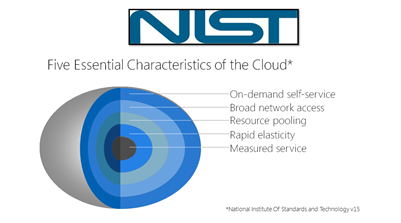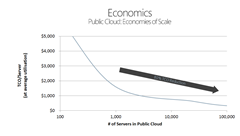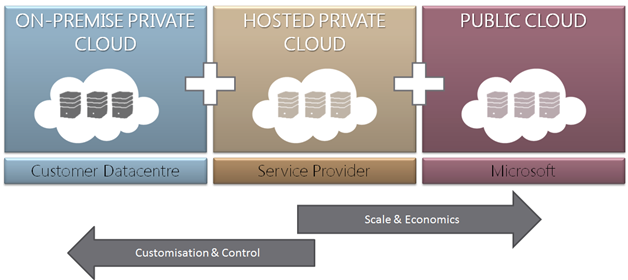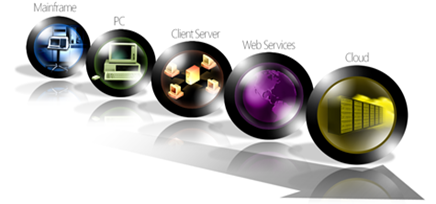Cloud Computing - Why Cloud?
Over the coming weeks, we have invited our colleague and cloud expert Nick Umney from Microsoft's UK National Technology Office, to post a series of blogs on all things cloud. These weekly blog posts will also touch upon the following topics as the series continues:
- delivering IT as a service
- infrastructure as a service in public sector
- platform as a service in public sector
- software as a service in public sector
- building a private cloud
- hybrid cloud
- considerations
In this first post, Nick answers the simple question 'why cloud?'...
---------------------------------------------
The adoption of the PC by businesses in the 90s dramatically changed the traditional mainframe/mini-computer environment that dominated the world of enterprise IT. It empowered individuals to apply technology creatively and broadly across organisations to the point where today it’s PC’s touch every element of our working and personal lives.
In the middle of the 1990s the Web emerged and a whole generation of Internet-facing Web applications, both Internet and Intranet, were built using HTML and Web servers. Web technologies remain a core model in developing applications today.
In the early 2000s Web services and SOA (Service-Oriented Architecture) enabled applications to communicate using standard-based Web protocols, be it Web services, or REST-based protocols. It promotes the ideal of assembling more complex solutions from simpler parts.
There are many advantages to the services model particularly with the immediacy of global reach, the ease of provisioning and, of course, allowing a 3rd party with the greater expertise to run the computers, networks, data-centres and software on my behalf. However, there are many advantages to running software on premises too. Principally, the ability to tailor the software to most effectively address specific business needs and the level of privacy and control that can only be guaranteed when the software and data are within my control.
 The cloud platform builds on previous platform generations but it is a fundamentally different approach and it has its own unique advantages.
The cloud platform builds on previous platform generations but it is a fundamentally different approach and it has its own unique advantages.
So is cloud computing just virtualisation or hosting by another name? The answer is of course no, Cloud brings a number of new characteristics to the delivery of IT services. These are best summarised by National Institute of Standards & Technology:
So what could cloud computing bring to Public Sector organisations? At Microsoft we articulate the benefits of cloud in three key areas: Agility, Focus & Economics.
Agility:
Public Cloud services enables organisations to move to utility computing (and start to consume IT much like electricity). The ability to switch on/switch off and pay for what you use is incredibly powerful. If an organisation hars a great idea, a pc, and a credit card they can buy compute time on the best datacentres on the planet.

This move to utility based computing gives organisations a unique ability to innovate. In short, to scale or to fail. This is massively useful in public sector supporting citizen services, open data, transparency, mobility etc etc.
In a traditional environment where organisations own their own infrastructure they can deploy a server and clock up a thousand hours of processing over a number of months. Using Public cloud services organisations have the ability to have a thousand cpu’s for an hour. What does this enable them to do differently?
In terms of applications Cloud services deliver the latest software to end users enabling new collaboration scenarios through anywhere access, collaboration over the internet and instant self-provisioning.
Focus:
Public Sector organisations exist to serve citizens, they are not technology companies. Consuming IT as a service enables the organisation to focus in on its business functions be that delivering healthcare to patients or housing benefits to citizens.
Economics:
 Global economic conditions and public sector fiscal constraints require more cost-efficient use of resources, even as demands to better serve citizens continue to grow. Government leaders have a critical need for a clear vision of where the IT industry is heading, and how the transition to cloud computing can contribute to their immediate needs for costs savings as well as their broader interests in economic growth.
Global economic conditions and public sector fiscal constraints require more cost-efficient use of resources, even as demands to better serve citizens continue to grow. Government leaders have a critical need for a clear vision of where the IT industry is heading, and how the transition to cloud computing can contribute to their immediate needs for costs savings as well as their broader interests in economic growth.
Public Cloud services operate with huge economies of scale beyond the reach of all public sector organisations let alone a single department or local authority. It is these economies of scale along with efficient utilisation (Public Cloud Services are available to multiple sectors and industries) that make cloud services economically attractive.
Microsoft has produced a new whitepaper - “The Economics of Cloud Computing for the EU Public Sector” which assesses the economics of the cloud by using in-depth modelling and analysis.
Cloud Services
To this point this post has mainly focussed on Public Cloud Services. These are available to multiple organisations, across multiple sectors and are delivered over the Internet. The are provided by a number of organisations, including Microsoft, today. This is not the end of the story though, customers want to take advantage of cloud services within their own environments, to make their own datacentre’s more efficient. In essence to build a Private Cloud. Customers want to share services across multiple organisations to reduce costs and facilitate collaboration. Typically these are delivered by a service provider (or in some instances a ‘lead’ customer), these are termed Hosted Private Clouds. Suffice to say that Microsoft fully supports all of these scenarios and each will be examined in later posts.
 Posted by Nick Umney
Posted by Nick Umney
Follow us on Twitter: @msukingov
